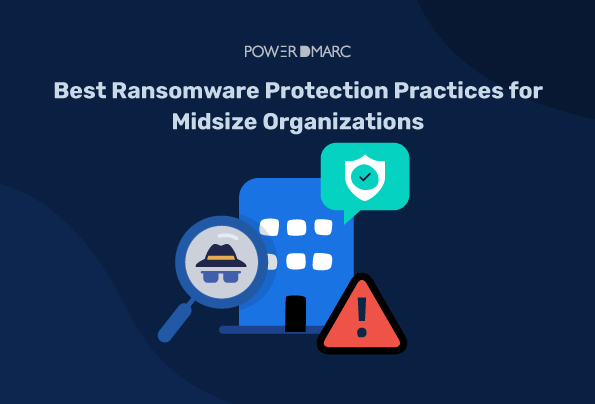Ransomware Protection has emerged as a crucial step in cybersecurity since ransomware attacks have become a major threat to businesses of all sizes, including midsize organizations. These attacks can cause massive operational disruption and financial loss.
Ransomware attacks can be delivered via email attachments or links, so it is crucial to have a robust email security system in place. This includes using email filters to block suspicious emails, training employees to recognize phishing emails, and regularly updating email software and security patches.
Key Takeaways
- Ransomware attacks are a significant threat to businesses, particularly midsize organizations, leading to operational disruptions and financial losses.
- Email security is essential for preventing ransomware, as emails are a common delivery method used by attackers.
- Midsize organizations face unique vulnerabilities including limited cybersecurity resources and insufficient employee training.
- Implementing advanced protective measures like EDR, SIEM, and user behavior analytics can enhance ransomware defenses.
- DMARC is a critical tool in email authentication that can help prevent phishing attacks and protect organizations from ransomware threats.
Ransomware: One of the Biggest Security Threats to Business in 2024
A recent survey by Cyber Security Hub looked at the state of cybersecurity in North America, Europe, and the Middle East. The survey found that 40% of the people surveyed said that their company experienced more cyber attacks in the last year.
The biggest threats identified were malware and ransomware, followed by targeting important employees and harmful mobile apps. Experts predict that this threat will continue to grow. Camila Serrano, chief security officer at MediaPeanut, says that geopolitical factors are now playing a bigger role in attacks on critical infrastructure.
Ransomware attacks are becoming more disruptive, and the attackers are demanding larger ransoms, causing significant problems for companies.
The people behind these attacks are constantly looking for any weaknesses in a company’s system to gain access and make a lot of money.
Once bad actors use fake emails to put harmful software into a company’s computers and networks, these attacks don’t stay in one place.
They move around, and access to these attacks is sometimes sold to people who specialize in ransomware. Ransomware groups know that big companies are more likely to pay a lot of money to get their information back. But even governments are not safe; in 2021, 48 government agencies in 21 countries got hit by ransomware.
The tactics of these bad actors are getting even sneakier. And with more businesses using cloud email, which has its security concerns, it’s super important to stop these bad actors from messing with a company’s data and information through email attacks.
Simplify Ransomware Protection with PowerDMARC!
Midsize Organizations: Understanding the Vulnerability to Ransomware Threats
Midsize organizations face unique cybersecurity challenges that can hinder their ability to protect themselves against ransomware threats:
Limited Cybersecurity Resources
Smaller organizations often lack the resources necessary to invest in advanced cybersecurity solutions and cybersecurity staff. However, even mid-sized businesses may not have the budget or personnel needed to address this threat adequately.
Insufficient Employee Training
Employees are often unaware of how ransomware works or how it can be prevented. This could lead to a successful attack by an adversary who targets employees who don’t know better.
This can be especially problematic if employees don’t understand what makes up normal activity on their network and mistakenly open a malicious email attachment or link they shouldn’t have.
Limited Budget for Advanced Security Measures
It’s difficult for mid-sized organizations to justify purchasing solutions such as advanced endpoint protection solutions (EPP) when they may not have the resources available to implement them properly at scale (i.e., across all devices).
Attractive Targets for Ransomware Actors
Ransomware has become one of the most common types of malware used by cybercriminals because it is profitable and relatively easy to deploy.
The criminals behind these attacks typically gain access to an organization’s network using phishing emails or other social engineering tactics before encrypting sensitive data and demanding a ransom payment in exchange for decryption keys.
Dependency on Third-Party Vendors
A major reason why midsize organizations are more susceptible to ransomware attacks is that they depend on third-party vendors for their services. When these vendors get hacked, or their data gets leaked, the entire organization becomes vulnerable to a ransomware attack.
Less Stringent Cybersecurity Policies
Another reason midsize organizations are vulnerable to ransomware attacks is that they do not have stringent cybersecurity policies in place as large corporations do.
They do not invest as much money in cybersecurity as large corporations, so they cannot spend as much time and resources on developing cybersecurity solutions for their business needs.
As a result, they tend to skip some steps while implementing security measures, which makes their systems even more vulnerable to cyber threats.
Email is the Most Common Delivery Method for Ransomware
Email remains the dominant delivery method for ransomware attacks in mid-sized organizations despite advancements in security and awareness.
Here are some key reasons why:
- Effectiveness: Email offers a direct line to employees, and attackers can craft personalized phishing emails that appear trustworthy, imitating colleagues, clients, or even internal systems.
- Human Error: Even in organizations with security training, employees can fall victim to well-crafted phishing emails, clicking malicious links or attachments that launch ransomware payloads.
- Ease of Access: Email addresses are readily available through public sources, data leaks, and social media. Attackers can automate large-scale phishing campaigns targeting mid-sized companies.
- Vulnerability: Many mid-sized organizations still rely on older email systems with known vulnerabilities. Attackers can exploit these weaknesses to deliver ransomware through automated attacks.
- Lack of Patching: Patching email systems and applications promptly can mitigate vulnerabilities, but resource constraints or outdated infrastructure can lead to delays, leaving organizations exposed.
- New Techniques: Attackers constantly develop new techniques, like “spear phishing,” targeting specific individuals within an organization or using zero-day vulnerabilities in email clients.
- Limited Resources: Mid-sized organizations may have smaller IT teams and resources compared to larger enterprises, making it harder to keep up with the evolving threat landscape.
What is the best protection against ransomware for Mid-Sized Organizations?
The main defense against ransomware is the same as any other cyber threat: prevention.
To protect against ransomware, you need to know what you’re watching for and be aware of the latest threats.
Here are some steps to take:
Endpoint Detection and Response (EDR)
EDR is a critical part of your defense strategy because it helps you detect suspicious activity and provides visibility into your endpoints.
It works by installing software on all endpoints to check their activities and generate alerts when something suspicious happens. Security personnel, who can take appropriate action if necessary, can then investigate the signs.
Network Segmentation
Network segmentation is another key component for preventing successful ransomware attacks. If a single system gets infected, malware can spread throughout your network quickly using shared folders or removable drives (such as USBs).
Segmenting your network into different zones limits this risk by restricting access between zones only when necessary.
Threat Intelligence Integration
Threat intelligence integration is an important tool for defending against cyberattacks in general because it helps keep you up-to-date on new threats as they emerge so that you can take appropriate action before they reach your systems.
Security Information and Event Management (SIEM)
SIEM solutions are designed to track and analyze network activity for any unusual or suspicious activity that could indicate a security breach.
The SIEM system allows you to quickly identify when an attack has occurred, track its progress, and mitigate the damage caused by an attack before it’s too late.
In addition to providing valuable insight into potential threats, SIEM systems also offer a central location where all security events are stored for further analysis and investigation.
Data Backup and Recovery Solutions
Backup solutions can help mid-sized organizations defend against ransomware by providing a copy of important data that can be restored if an attack occurs.
This allows them to recover from an attack without paying a ransom, which is often less expensive than paying the ransom and restoring your systems from backup.
Advanced Firewalls and Intrusion Prevention Systems (IPS)
Mid-sized organizations should also consider investing in advanced firewalls and intrusion prevention systems (IPS). These tools can help prevent ransomware infections by blocking malicious files before they reach your network.
User Behavior Analytics (UBA)
This type of technology monitors users’ activities on their devices to identify any suspicious activity that could indicate an impending attack.
For example, if someone logs into your network from an unfamiliar location or uses an unknown device, you’ll be notified immediately so you can take action before it’s too late.
Email Filtering and Anti-Phishing Solutions
These tools scan emails for spam content and phishing links before they reach your inboxes so that employees don’t have access to malicious links or attachments that could lead to infection.
Why Email Security is Pivotal in Ransomware Protection
Recognizing the importance of email security is crucial in guarding against ransomware. Email is a major way ransomware enters organizations, taking advantage of human behavior by tricking people into clicking on harmful links or attachments.
It’s not just about stopping attacks but also about preventing them from causing big problems and expenses.
Imagine email security as a superhero that can potentially stop ransomware right at the beginning, avoiding the chaos and costs of a successful attack.
Today’s email security solutions are like guardians, protecting both big and small organizations from many ransomware attacks that are being spread via fake emails.
Enhance Priliminary Ransomware Protection with DMARC
Domain-based Message Authentication, Reporting, and Conformance (DMARC) stands as a crucial first line of defense. But how does DMARC contribute to safeguarding your organization from the threat of ransomware?
DMARC Authentication to Counter Spoofing
Ransomware often enters through deceptive phishing emails that pretend to be from trusted company domains. DMARC, when properly set up, shields your brand by making sure that fake emails are either marked as spam or prevented from reaching recipients altogether.
How DMARC Fights Ransomware?
DMARC is your first line of defence against Ransomware. It strengthens your email authentication by validating messages through SPF (Sender Policy Framework) and DKIM (DomainKeys Identified Mail) standards.
Here’s how it works against ransomware attacks:
- Phishing Email Arrival: When a phishing email, created by a malicious actor and containing a dangerous link that can install ransomware, arrives from your domain, DMARC steps in.
- SPF and DKIM Verification: The receiving server checks the sending source’s authenticity and/or the DKIM signature.
- Verification Failure: If the email fails, these checks, DMARC identifies a domain misalignment.
- DMARC Authentication (Enforced Policy Mode): In enforced policy mode (p=reject/quarantine), DMARC ensures that the email, after failing authentication, is either marked as spam or completely rejected, effectively thwarting the ransomware threat.
- Avoiding SPF Errors: DMARC also helps prevent SPF errors, including those related to DNS lookups, syntax, and implementation, ensuring the ongoing validity of your email authentication.
By following these steps, DMARC protects your brand’s reputation, sensitive information, and financial assets, making it an indispensable tool in the battle against ransomware.
To kickstart your journey toward enhanced ransomware protection, sign up for DMARC analyzer today.
- Microsoft Sender Requirements Enforced— How to Avoid 550 5.7.15 Rejections - April 30, 2025
- How to Prevent Spyware? - April 25, 2025
- How to Set Up SPF, DKIM, and DMARC for Customer.io - April 22, 2025




